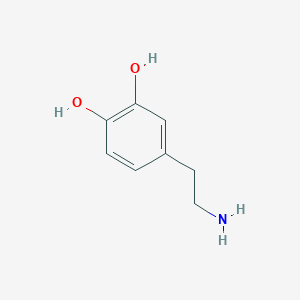Details of Metabolite
| Full List of Protein(s) Regulating This Metabolite | ||||||
|---|---|---|---|---|---|---|
| Equilibrative nucleoside transporter (ENT) | ||||||
| Solute carrier family 29 member 4 (SLC29A4) | Click to Show/Hide the Full List of Regulating Pair(s): 2 Pair(s) | |||||
| Detailed Information |
Protein Info
 click to show the details of this protein click to show the details of this protein
|
|||||
| Regulating Pair (1) |
Experim Info
 click to show the details of experiment for validating this pair click to show the details of experiment for validating this pair
|
[1] | ||||
| Introduced Variation | Mutation (138T) of SLC29A4 | |||||
| Induced Change | Dopamine concentration: decrease | |||||
| Summary | Introduced Variation
|
|||||
| Disease Status | Asperger syndrome [ICD-11: 6A02] | |||||
| Details | It is reported that mutation (138T) of SLC29A4 leads to the decrease of dopamine levels compared with control group. | |||||
| Regulating Pair (2) |
Experim Info
 click to show the details of experiment for validating this pair click to show the details of experiment for validating this pair
|
[1] | ||||
| Introduced Variation | Mutation (D326E) of SLC29A4 | |||||
| Induced Change | Dopamine concentration: decrease | |||||
| Summary | Introduced Variation
|
|||||
| Disease Status | Asperger syndrome [ICD-11: 6A02] | |||||
| Details | It is reported that mutation (D326E) of SLC29A4 leads to the decrease of dopamine levels compared with control group. | |||||
| GPCR glutamate (GPCR-3) | ||||||
| Glutamate receptor mGLU2 (mGluR2) | Click to Show/Hide the Full List of Regulating Pair(s): 1 Pair(s) | |||||
| Detailed Information |
Protein Info
 click to show the details of this protein click to show the details of this protein
|
|||||
| Regulating Pair |
Experim Info
 click to show the details of experiment for validating this pair click to show the details of experiment for validating this pair
|
[2] | ||||
| Introduced Variation | Knockout of Grm2 | |||||
| Induced Change | Dopamine concentration: decrease (FC = 0.75) | |||||
| Summary | Introduced Variation
|
|||||
| Disease Status | Healthy individual | |||||
| Details | It is reported that knockout of mGlu2/3 leads to the decrease of dopamine levels compared with control group. | |||||
| Glutamate receptor mGLU3 (mGluR3) | Click to Show/Hide the Full List of Regulating Pair(s): 1 Pair(s) | |||||
| Detailed Information |
Protein Info
 click to show the details of this protein click to show the details of this protein
|
|||||
| Regulating Pair |
Experim Info
 click to show the details of experiment for validating this pair click to show the details of experiment for validating this pair
|
[2] | ||||
| Introduced Variation | Knockout of Grm3 | |||||
| Induced Change | Dopamine concentration: decrease (FC = 0.75) | |||||
| Summary | Introduced Variation
|
|||||
| Disease Status | Healthy individual | |||||
| Details | It is reported that knockout of mGlu2/3 leads to the decrease of dopamine levels compared with control group. | |||||
| GPCR rhodopsin (GPCR-1) | ||||||
| Dopamine D4 receptor (D4R) | Click to Show/Hide the Full List of Regulating Pair(s): 1 Pair(s) | |||||
| Detailed Information |
Protein Info
 click to show the details of this protein click to show the details of this protein
|
|||||
| Regulating Pair |
Experim Info
 click to show the details of experiment for validating this pair click to show the details of experiment for validating this pair
|
[3] | ||||
| Introduced Variation | Knockout of Drd4 | |||||
| Induced Change | Dopamine concentration: decrease (FC = 0.28) | |||||
| Summary | Introduced Variation
|
|||||
| Disease Status | Healthy individual | |||||
| Details | It is reported that knockout of DRD4 leads to the decrease of dopamine levels compared with control group. | |||||
| Pore-forming PNC peptide (PNC) | ||||||
| Cellular tumor antigen p53 (TP53) | Click to Show/Hide the Full List of Regulating Pair(s): 1 Pair(s) | |||||
| Detailed Information |
Protein Info
 click to show the details of this protein click to show the details of this protein
|
|||||
| Regulating Pair |
Experim Info
 click to show the details of experiment for validating this pair click to show the details of experiment for validating this pair
|
[4] | ||||
| Introduced Variation | Knockout of TP53 | |||||
| Induced Change | Dopamine concentration: decrease (Log2 FC=0.8) | |||||
| Summary | Introduced Variation
|
|||||
| Disease Status | Colon cancer [ICD-11: 2B90] | |||||
| Details | It is reported that knockout of TP53 leads to the decrease of dopamine levels compared with control group. | |||||
If you find any error in data or bug in web service, please kindly report it to Dr. Zhang and Dr. Mou.

